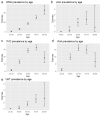Prevalence, Concordance, and Heritability of Vitreomacular Interface Abnormalities in a Twin Study
- PMID: 37428499
- PMCID: PMC10341355
- DOI: 10.1167/iovs.64.10.9
Prevalence, Concordance, and Heritability of Vitreomacular Interface Abnormalities in a Twin Study
Abstract
Purpose: The relative importance of genetic factors in common vitreomacular interface (VMI) abnormalities is unknown. The aim of this classical twin study is to determine the prevalence case wise concordance between monozygotic and dizygotic twin pairs, and heritability of common VMI abnormalities, including epiretinal membrane (ERM), posterior vitreous detachment (PVD), vitreomacular adhesion (VMA), vitreomacular traction (VMT), lamellar macular holes (LMHs), and full-thickness macular holes (FTMHs).
Methods: This is a single-center, cross-sectional classical twin study of 3406 TwinsUK participants over the age of 40 years who underwent spectral domain macular optical coherence tomography (SD-OCT) scans which were graded for signs of VMI abnormalities. Case wise concordance was calculated and the heritability of each VMI abnormality was estimated using OpenMx structural equation modeling.
Results: In this population (mean age = 62.0 years [SD = 10.4 years], range = 40-89 years) the overall prevalence of ERM was 15.6% (95% confidence interval [CI] = 14.4-16.9) and increased with age, posterior vitreous detachment affected 21.3% (20.0-22.7), and VMA was diagnosed in 11.8% (10.8-13.0). Monozygotic twins were more concordant for all traits than dizygotic twins, and age, spherical equivalent refraction (SER), and lens status-adjusted heritability was estimated at 38.9% (95% CI = 33.6-52.8) for ERM, 53.2% (95% CI = 41.8-63.2) for PVD, and 48.1% (95% CI = 33.6-58) for VMA.
Conclusions: Common VMI abnormalities are heritable and therefore have an underlying genetic component. Given the sight-threatening potential of VMI abnormalities, further genetic studies, such as genomewide association studies, would be useful to identify genes and pathways implicated in their pathogenesis.
Conflict of interest statement
Disclosure:
Figures


References
-
- Mitchell P, Smith W, Chey T, et al. .. Prevalence and associations of epiretinal membranes. The Blue Mountains Eye Study, Australia. Ophthalmology. 1997; 104: 1033–1040. - PubMed
-
- Kawasaki R, Wang JJ, Sato H, et al. .. Prevalence and associations of epiretinal membranes in an adult Japanese population: the Funagata study. Eye (Lond). 2009; 23: 1045–1051. - PubMed
Publication types
MeSH terms
Grants and funding
LinkOut - more resources
Full Text Sources
Medical

